
HP603, HP605, LX7, LX17 Digital Pianos - Recommended - In the competitive world of digital pianos, the top digital manufacturers such as Yamaha, Roland, Kawai, Casio, and others are always trying to compete for having the best pianos at the most reasonable prices...and they all do a good job of that. Digital piano technology is getting more realistic and exiting each time a new model comes out and these top manufacturers all have great products,
although there are some models that are better than others in trying to reproduce a great acoustic piano playing experience in a digital piano, in my opinion. So when the Roland company comes out with new piano products, people that know and play music are usually impressed. After all, Roland is not only known for building some great digital upright & grand pianos for beginners through accomplished pianists with their pianos being found on stage, in famous Universities, in recording studios, churches, schools, and other venues, but Roland also builds other types of music products too. Their other famous music products range from digital drum sets, to digital organs, to digital accordions, to digital guitar products, to stage synthesizers & digital pianos, to expensive digital harpsichords, to pro audio/speaker products, to music computer technology, to pro recording gear, and the list goes on. Roland music products are used by anyone wanting great performance and reliable product. I have personally owned a variety of Roland music products as well as playing them professionally and have enjoyed them over the years. They are certainly not the only brand I use or own, but they are right near the top.
When Roland inoduced their latest line of new digital pianos about 1 year ago, many people thought these instruments would likely be a rehash of previous HP/LX piano technology with a few minor changes and upgrades and that Roland would just go about business as usual.Well...after I recently played the new Roland HP603 in black or rosewood satin finishes ($3199 retail price), HP605 in black or rosewood satin finishes ($3899 retail price) and in polished ebony ($4499 retail price), LX7 in custom walnut or black satin finishes ($5699US retail price) and in polished ebony ($6299 retail price), and the top of the line LX17 in either
polished ebony or polished white finish ($6999S retail price), I can tell you that Roland has entered into a new dimension of piano sound technology as well as designing a new key action and new internal speaker systems, and even some new cabinet designs and finishes that exceeded what I had expected from them. Even the popular satin rosewood finish has been redone from previous models and upgraded to look a bit more natural with more wood grain and color, although it's not real wood:). In other words, these new Roland pianos impressed me with what I considered to be a more natural piano playing experience than I have had on a Roland piano previous to this, and I have played them all. This does not mean a person (including myself) cannot enjoy playing on the other major brands of digital pianos because you certainly can enjoy them. But what it does mean is that Roland is trying to recreate a real acoustic piano playing experience in a different way given the available technology, and there are some things I like very much about it and some things I do not like as much. It is important for me to note that the new HP & LX models are not available for purchase on the internet in the US. You can only find them in local piano stores that carry these models and you may or may not have a Roland store near you. If you are in the US and want more info on this please let me know.
| LX7 satin walnut |
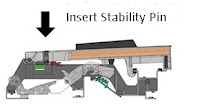 key is not all plastic and not all wood as you would normally find in the other popular digital piano brands and Roland would claim this is the best way to produce a key in a digital piano. I personally don't know if it's the best way to make a key and I doubt that the small amount of wood in the key does too much other than look nice, but as long as the keys move smoothly, are balanced well, and are graded weighted in a satisfying way, then that's what I look for, and I believe this new key action called the PHA50 does all that. It is an upgrade to the previous top of the line key action called the "Concert Action" which Roland had in their previous HP506, HP508, LX15e. HPi50e, and DP90Se. Although I always felt that the Concert Key Action was very good and enjoyable to play, this new PHA50 action is even more so and I did notice some advantages.
key is not all plastic and not all wood as you would normally find in the other popular digital piano brands and Roland would claim this is the best way to produce a key in a digital piano. I personally don't know if it's the best way to make a key and I doubt that the small amount of wood in the key does too much other than look nice, but as long as the keys move smoothly, are balanced well, and are graded weighted in a satisfying way, then that's what I look for, and I believe this new key action called the PHA50 does all that. It is an upgrade to the previous top of the line key action called the "Concert Action" which Roland had in their previous HP506, HP508, LX15e. HPi50e, and DP90Se. Although I always felt that the Concert Key Action was very good and enjoyable to play, this new PHA50 action is even more so and I did notice some advantages. | HP603 Rosewood |
It is definitely worth mentioning that the new top-of-the-line PHA-50 key action is on all of the new Roland models instead of just some of them as like they did in past models.
This is not the case with Kawai and Yamaha digital pianos where they reserve their best key actions for their more expensive models. In fact, Yamaha's best (CLP) digital piano key action is exclusively in their most expensive CLP Clavinova piano which retails for $6299 whereas the Roland PHA50 key action (which I personally like better) is found starting in the Roland HP603 for just $3199 retail. Since there is a $3000 spread in price of these two models, you might be thinking that the YamahP585 key action must be much etter because that piano costs a lot more money, but in my opinion that is just not the case. The Roland PHA50 key action (left pic cutaway) is every bit as good as the Yamaha key action in my opinion, and in some noticeable ways even more authentic. So price alone in a digital piano does not determine quality or realism when compared to a real acoustic piano. I will say that Yamaha has an actual all-wood complete acoustic (upright) key action in a digital piano they call the NU1 and that model sells for approx $5000 at discount. I have played the NU1 many times and it has a much better more authentic key action, in my opinion, as compared to any of the Yamaha Clavinova CLP key actions. However, the downside of the NU1 key action is that it is based on an acoustic upright console key action and not a grand piano key action so the key movement is not at all like a grand whereas the new Roland key action moves and feels a bit more like a grand piano as compared to an upright piano, but there are no actual moving hammers in the Roland pianos like in a real piano.
 The new Roland key action also has the "escapement feature" which simulates the movement of grand piano keys when you press them down slowly and easily and you feel them slightly hesitate or have a notch or bump that occurs as you press the key down. This type of feeling is a natural occurrence on a real grand piano and helps with key control when playing music legato and slowly. You can actually distinctly feel this "escapement" key action feature in the Roland pianos. However in all of the newer Yamaha Clavinova CLP pianos, although Yamaha has added the escapement feature for the first time ever in these recent models, unfortunately it feels like it's not even there. In other words, the escapement feel is so subtle that it's difficult to feel it at all when playing softly and slowly. This has not been my experience on real acoustic pianos where that "escapement" mechanism experience is much more noticeable and distinct without being overpowering. So just because the feature may be there, it doesn't mean it's working well, and in my opinion the Roland escapement feature is more authentic but is still a simulation and not the real thing. Kawai also uses the escapement feature, which they call "let-off" (just another name for the same thing) and the Kawai feature is more pronounced and more similar to Roland in that way.
The new Roland key action also has the "escapement feature" which simulates the movement of grand piano keys when you press them down slowly and easily and you feel them slightly hesitate or have a notch or bump that occurs as you press the key down. This type of feeling is a natural occurrence on a real grand piano and helps with key control when playing music legato and slowly. You can actually distinctly feel this "escapement" key action feature in the Roland pianos. However in all of the newer Yamaha Clavinova CLP pianos, although Yamaha has added the escapement feature for the first time ever in these recent models, unfortunately it feels like it's not even there. In other words, the escapement feel is so subtle that it's difficult to feel it at all when playing softly and slowly. This has not been my experience on real acoustic pianos where that "escapement" mechanism experience is much more noticeable and distinct without being overpowering. So just because the feature may be there, it doesn't mean it's working well, and in my opinion the Roland escapement feature is more authentic but is still a simulation and not the real thing. Kawai also uses the escapement feature, which they call "let-off" (just another name for the same thing) and the Kawai feature is more pronounced and more similar to Roland in that way.When it comes to piano sound and getting as close to approximating or matching a real acoustic piano, there is no digital piano that can exactly reproduce a real acoustic grand piano sound regardless of what anyone else may say. It simply has never been done and no digital piano brand can rightly claim that they have done it. So the next best thing is "how close can a digital piano get to a real acoustic piano sound playing experience?" If you knew how complex a real acoustic piano sound actually is and what is actually happening in a good grand piano when it comes to the piano sound itself (what it does and how you hear it), you would probably drop your jaw open and think it would be impossible to recreate digitally because there are certain piano sound elements that happen in "real time" that are always changing depending on how fast or slow you play the keys, how hard or soft you hit (play) the
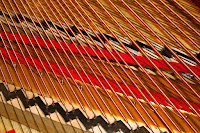 keys, the type of wood the piano is made of, how much soundboard space you have in the real piano, the types of hammers and key felt that is part of the key action, the vibrations and overtones of the 230 strings (give or take) in a real grand piano and how they all interact with each other including the random vibrations, sympathetic noises, frequency changes, tonal dynamics, string thickness, string windings and materials, the scale design, the piano iron frame, dampers and their affect on the sound, decay and sustain time of the sustained strings, volume, duration of the tone and changes in velocity, among other things. Even the the style of music you play such as chording, voicing of chords, staccato and legato of the notes, and the interaction of the string vibrations on the body of the piano all contribute to the final outcome of the sound. Not only are thekey action elements quite complex in a real acoustic piano, but in a lot of ways the piano sound is even more complex and trying to get that "perfect" reproduction which people are looking for in a digital piano is very difficult given the current sampling technology that most digital piano companies are using.
keys, the type of wood the piano is made of, how much soundboard space you have in the real piano, the types of hammers and key felt that is part of the key action, the vibrations and overtones of the 230 strings (give or take) in a real grand piano and how they all interact with each other including the random vibrations, sympathetic noises, frequency changes, tonal dynamics, string thickness, string windings and materials, the scale design, the piano iron frame, dampers and their affect on the sound, decay and sustain time of the sustained strings, volume, duration of the tone and changes in velocity, among other things. Even the the style of music you play such as chording, voicing of chords, staccato and legato of the notes, and the interaction of the string vibrations on the body of the piano all contribute to the final outcome of the sound. Not only are thekey action elements quite complex in a real acoustic piano, but in a lot of ways the piano sound is even more complex and trying to get that "perfect" reproduction which people are looking for in a digital piano is very difficult given the current sampling technology that most digital piano companies are using.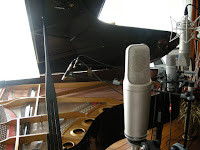 I am a long time piano teacher and pro musician of 40 plus years having taught thousands of students as well as owning, playing on, and teaching acoustic guitar. When it comes to natural grand piano sound, to me that is what it's all about...beauty, soul, feeling, the piano sound being alive and not digital sounding, and feeling like when you play a song, you can play it may times and every time it comes out a bit differently because a real piano sound is "alive & breathing" and changes, and is not canned, digital, dead, plunky, or without taste or expression. I mention all of this so that you will better understand what I am about to share with you. Up until now, Roland, Yamaha, Kawai, and Casio, the four main digital piano companies out there, have been using "sample recording" technology to capture piano sound from a real piano and then put it into the digital micro-processor chip in the digital piano so that it comes out of the speakers and sounds as much like a real piano as possible using that sampling technology. The "samples" or recordings are of each piano note (not each string) on a particular brand and model of acoustic grand piano at different velocity levels when pressing the keys and those recordings, which are done by microphones inside and over the acoustic piano, are relatively short samples of the sound due to digital memory constraints. This is true for all major brand digital pianos. Yamaha uses Yamaha acoustic grands, Kawai uses Kawai acoustic grands, and so on. The sample is then electronically "looped" into a continuous virtual circle/loop so that it will sound like it is continuous in real time linear playback. But when you play a real piano, the piano sound starts when you first touch the key and hear the sound and then it stops when you let go of the key and pedal. That acoustic piano sound is one straight continuous ever-changing sound in real time. Sampled recording is actually taking a slice or piece of that original piano sound and then is looped in a virtual circle, as I just mentioned, so it plays over & over and is not actually real-time changing linear sound. Picture a hula-hoop going around & around. The hula-hoop is a circle fastened together at a starting & ending point much like a sample recording is done. This is the way piano sound is heard on a digital piano. Depending on how and where the loop is electronically fastened together, you may or may not hear a noticeable or slight anomaly (depending on the loop) or strange tone when the loop starts over. In other words, the sound will end and then quickly start over while you are holding the piano key down and you may hear something unnatural because of that process...or you may not hear it. It just depends on your ears and how sensitive they are to a real piano sound and how good the sampling process was on the brand & model. Kawai, Yamaha, and the new Casio Hybrids all do a very good job with their sample looping, but some of the off brands is where you notice problems in sampling process.
I am a long time piano teacher and pro musician of 40 plus years having taught thousands of students as well as owning, playing on, and teaching acoustic guitar. When it comes to natural grand piano sound, to me that is what it's all about...beauty, soul, feeling, the piano sound being alive and not digital sounding, and feeling like when you play a song, you can play it may times and every time it comes out a bit differently because a real piano sound is "alive & breathing" and changes, and is not canned, digital, dead, plunky, or without taste or expression. I mention all of this so that you will better understand what I am about to share with you. Up until now, Roland, Yamaha, Kawai, and Casio, the four main digital piano companies out there, have been using "sample recording" technology to capture piano sound from a real piano and then put it into the digital micro-processor chip in the digital piano so that it comes out of the speakers and sounds as much like a real piano as possible using that sampling technology. The "samples" or recordings are of each piano note (not each string) on a particular brand and model of acoustic grand piano at different velocity levels when pressing the keys and those recordings, which are done by microphones inside and over the acoustic piano, are relatively short samples of the sound due to digital memory constraints. This is true for all major brand digital pianos. Yamaha uses Yamaha acoustic grands, Kawai uses Kawai acoustic grands, and so on. The sample is then electronically "looped" into a continuous virtual circle/loop so that it will sound like it is continuous in real time linear playback. But when you play a real piano, the piano sound starts when you first touch the key and hear the sound and then it stops when you let go of the key and pedal. That acoustic piano sound is one straight continuous ever-changing sound in real time. Sampled recording is actually taking a slice or piece of that original piano sound and then is looped in a virtual circle, as I just mentioned, so it plays over & over and is not actually real-time changing linear sound. Picture a hula-hoop going around & around. The hula-hoop is a circle fastened together at a starting & ending point much like a sample recording is done. This is the way piano sound is heard on a digital piano. Depending on how and where the loop is electronically fastened together, you may or may not hear a noticeable or slight anomaly (depending on the loop) or strange tone when the loop starts over. In other words, the sound will end and then quickly start over while you are holding the piano key down and you may hear something unnatural because of that process...or you may not hear it. It just depends on your ears and how sensitive they are to a real piano sound and how good the sampling process was on the brand & model. Kawai, Yamaha, and the new Casio Hybrids all do a very good job with their sample looping, but some of the off brands is where you notice problems in sampling process.| Previous discontinued model HP506 |
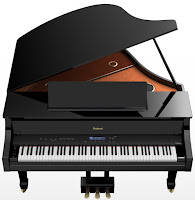 However, Roland has now gone beyond the standard industry piano sound "sampling" technology by introducing a new sound technology in this $3000-$7500 digital piano furniture cabinet price range called SuperNATURAL piano Modeling. Modeling (aka: modelling)is different from sampling in the way the sound is created and the way you hear it when the piano is being played. Along with this technology being implemented to create an all new piano sound not found in any other major brand, Roland is putting it in all of their new models instead of just a few at the top of the price range. This means that you can get this new technology of piano sound reproduction starting at around $3000 in their cabinet models. It is typical for digital piano companies to reserve their best features for the most expensive models to get you to spend more money but Roland did not do this, and that is impressive to me and I commend them for that. So exactly what is SuperNATURAL Modeling technology and what makes it different then all other digital pianos? In Sampling technology, the sound elements in a real piano need to be recorded with microphones, as I previously mentioned, and then those recordings need to be translated into computers and then saved in the digital piano sound chips on circuit boards. The recordings can be of a number of different things in a piano including the sound reproduction as you strike a key at different velocities and the noise the hammer makes when it moves, just to name a few. Sampled sounds take a larger amount of computer memory to do it correctly (or as close as can be done), and that may or may not drive up the cost of those instruments. But those sound element recordings never change and cannot "think" on their own such as what real acoustic pianos do in the natural physical world. The technology is also limited by the recording microphones and their ability to get a pure organic sound through the air.
However, Roland has now gone beyond the standard industry piano sound "sampling" technology by introducing a new sound technology in this $3000-$7500 digital piano furniture cabinet price range called SuperNATURAL piano Modeling. Modeling (aka: modelling)is different from sampling in the way the sound is created and the way you hear it when the piano is being played. Along with this technology being implemented to create an all new piano sound not found in any other major brand, Roland is putting it in all of their new models instead of just a few at the top of the price range. This means that you can get this new technology of piano sound reproduction starting at around $3000 in their cabinet models. It is typical for digital piano companies to reserve their best features for the most expensive models to get you to spend more money but Roland did not do this, and that is impressive to me and I commend them for that. So exactly what is SuperNATURAL Modeling technology and what makes it different then all other digital pianos? In Sampling technology, the sound elements in a real piano need to be recorded with microphones, as I previously mentioned, and then those recordings need to be translated into computers and then saved in the digital piano sound chips on circuit boards. The recordings can be of a number of different things in a piano including the sound reproduction as you strike a key at different velocities and the noise the hammer makes when it moves, just to name a few. Sampled sounds take a larger amount of computer memory to do it correctly (or as close as can be done), and that may or may not drive up the cost of those instruments. But those sound element recordings never change and cannot "think" on their own such as what real acoustic pianos do in the natural physical world. The technology is also limited by the recording microphones and their ability to get a pure organic sound through the air. Physical Modeling sound is not recorded from an acoustic piano but is created through non sampling computer mathematical algorithms. I am definitely not a mathematician so the best explanation I found on the subject which I believe is important to understand (at some level) so that you can appreciate this new piano sound technology, is as follows: "In sound synthesis, physical modeling synthesis refers to methods in which the waveform of the sound to be generated is computed by using a mathematical model or formula, being a set of equations and algorithms to simulate a physical source of sound, usually a musical instrument. Such a model consists of laws of physics that govern the sound production, and will typically have several parameters, some of which are constants that describe the physical materials and dimensions of the instrument, while others are time-dependent functions that describe the player's interaction with it, such as plucking a string, or covering toneholes. For example, to model the sound of a drum, there would be a formula for how striking the drumhead injects energy into a two dimensional membrane. Thereafter the properties of the membrane (mass density, stiffness, etc.), its coupling with the resonance of the cylindrical body of the drum, and the conditions at its boundaries (a rigid termination to the drum's body) would describe its movement over time and thus its generation of sound." That's the explanation I found that best suits the technology.
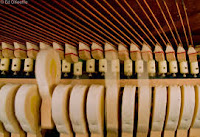 In piano sound physical modeling, that technology is dealing with things such as the energy/force you put into the playing the keys, the interaction of the tonal dynamics, piano hammers, felt movement on the hammers, string movement over time, overtones that excite other moving and non-moving parts of the strings and wood cabinet, and many more physical aspects of a real acoustic piano.,..and all of these physical properties in a real piano are recreated by computer computations. It's like a powerful computer that draws a "virtual picture" of every aspect of the best acoustic grand piano possible and then that "virtual picture" instantly comes to life as that actual acoustic piano played instantly in micro seconds with no repetition or sameness. This gives you thefeeling that the piano sound which you're hearing coming through the speaker system is being generated from a realacoustic piano, when in fact is is all done in the virtual technology world. Instead of audio recordings that cannot recreate some of the acoustic organic tendencies and variations that real acoustic pianos can project, the physical modeled piano incorporates things like the actual individual staples in each of the felt hammers, the weight of each felt hammer, the speed in micro seconds at which keys move, the vibration rate of each of the 230 piano strings at different key stroke velocities, the wood action parts and the glue, leather, felt, suede, carbon fiber and other material that may be used in real pianos to make things happen. There is no limit to sound recreation using physical modelling technology, but there are limits using the standard sampling technology. Imagine trying to record the vibration sound rates of each string at over 20 velocities across the entire keyboard of strings...it is impossible in the real physical world to do, but it is something that can be done in the virtual world of physical modelling. You could (if this feature was included, but it is not) even change the material in the strings from copper, to silver, to rubber bands if you really wanted to along with the tonal characteristics of those materials:). I would not want to hear what 230 different sized rubber bands sound like with piano hammers hitting them, but it could be done with virtual physical modelling.. By the way, Roland is using complete physical modeling technology for the piano sounds and all aspects of the sound whereas Yamaha, who also makes some nice digital pianos and uses some physical modeling, has it to generate the reverb resonance feature only but the piano sounds are sampled. Polyphony is limited to 256 notes (which is really not a problem) and the reverb physical modeling is limited to their two top models only. Roland has complete (100%) actual physical modeling coming for the entire sound (there is no sampling). Are you getting the picture now?:)
In piano sound physical modeling, that technology is dealing with things such as the energy/force you put into the playing the keys, the interaction of the tonal dynamics, piano hammers, felt movement on the hammers, string movement over time, overtones that excite other moving and non-moving parts of the strings and wood cabinet, and many more physical aspects of a real acoustic piano.,..and all of these physical properties in a real piano are recreated by computer computations. It's like a powerful computer that draws a "virtual picture" of every aspect of the best acoustic grand piano possible and then that "virtual picture" instantly comes to life as that actual acoustic piano played instantly in micro seconds with no repetition or sameness. This gives you thefeeling that the piano sound which you're hearing coming through the speaker system is being generated from a realacoustic piano, when in fact is is all done in the virtual technology world. Instead of audio recordings that cannot recreate some of the acoustic organic tendencies and variations that real acoustic pianos can project, the physical modeled piano incorporates things like the actual individual staples in each of the felt hammers, the weight of each felt hammer, the speed in micro seconds at which keys move, the vibration rate of each of the 230 piano strings at different key stroke velocities, the wood action parts and the glue, leather, felt, suede, carbon fiber and other material that may be used in real pianos to make things happen. There is no limit to sound recreation using physical modelling technology, but there are limits using the standard sampling technology. Imagine trying to record the vibration sound rates of each string at over 20 velocities across the entire keyboard of strings...it is impossible in the real physical world to do, but it is something that can be done in the virtual world of physical modelling. You could (if this feature was included, but it is not) even change the material in the strings from copper, to silver, to rubber bands if you really wanted to along with the tonal characteristics of those materials:). I would not want to hear what 230 different sized rubber bands sound like with piano hammers hitting them, but it could be done with virtual physical modelling.. By the way, Roland is using complete physical modeling technology for the piano sounds and all aspects of the sound whereas Yamaha, who also makes some nice digital pianos and uses some physical modeling, has it to generate the reverb resonance feature only but the piano sounds are sampled. Polyphony is limited to 256 notes (which is really not a problem) and the reverb physical modeling is limited to their two top models only. Roland has complete (100%) actual physical modeling coming for the entire sound (there is no sampling). Are you getting the picture now?:)  Roland seems to have always gone after the Steinway Concert grand piano sound and that's what they have done here with these new digital pianos in getting them to behave much the same way as the real thing does. Having this kind of technology gives the player an approximation of Steinway grand sound characteristics without the large size and expense of that acoustic piano. In fact, it could be said that the new Roland digital piano sound is so lifelike and organic that it sounds like there are no speakers in the digital piano itself and that the sound is naturally occurring within the cabinet and not coming through speakers. An example of this is when you press any one key in the Roland piano by itself without having any additional reverb or sound effects on, that one note will trigger natural occurring overtones for that specific note that you would normally and naturally hear in a real piano. Just take my word for it, it really does do that and no other major digital piano brand has that capability...and just when a person thought that 256-note polyphony processing power for the piano sound was a lot, the new Roland physical modelling technology has jumped that polyphony number up to...infinity and beyond:)...in other words... unlimited polyphony. There is no limit because of the way the sound is generated in the virtual physical world. However, the 256-note polyphony in other name brand pianos is way more than enough to power even some of the most complex piano music that a person can play. The unlimited polyphony on the Roland pianos is for the acoustic piano sounds but for the non-acoustic piano instruments such as electric pianos, strings, organs, choirs, brass, etc...it's 384-note polyphony which is also more than the other brands do, but once again, not something that you'll actually notice when playing these instrumental sounds. Also, polyphony power has nothing to do with the actual instrument sound samples and the authenticity of those tones. However, when you combine that polyphony power along with a 3-sensor key action, the musical expression and dynamic tonal & volume range you get in these new pianos is very impressive. From very soft pianissimo to extra loud Forte volume. these new pianos go beyond what a person might otherwise expect out of a digital piano, particularly a Roland digital piano.
Roland seems to have always gone after the Steinway Concert grand piano sound and that's what they have done here with these new digital pianos in getting them to behave much the same way as the real thing does. Having this kind of technology gives the player an approximation of Steinway grand sound characteristics without the large size and expense of that acoustic piano. In fact, it could be said that the new Roland digital piano sound is so lifelike and organic that it sounds like there are no speakers in the digital piano itself and that the sound is naturally occurring within the cabinet and not coming through speakers. An example of this is when you press any one key in the Roland piano by itself without having any additional reverb or sound effects on, that one note will trigger natural occurring overtones for that specific note that you would normally and naturally hear in a real piano. Just take my word for it, it really does do that and no other major digital piano brand has that capability...and just when a person thought that 256-note polyphony processing power for the piano sound was a lot, the new Roland physical modelling technology has jumped that polyphony number up to...infinity and beyond:)...in other words... unlimited polyphony. There is no limit because of the way the sound is generated in the virtual physical world. However, the 256-note polyphony in other name brand pianos is way more than enough to power even some of the most complex piano music that a person can play. The unlimited polyphony on the Roland pianos is for the acoustic piano sounds but for the non-acoustic piano instruments such as electric pianos, strings, organs, choirs, brass, etc...it's 384-note polyphony which is also more than the other brands do, but once again, not something that you'll actually notice when playing these instrumental sounds. Also, polyphony power has nothing to do with the actual instrument sound samples and the authenticity of those tones. However, when you combine that polyphony power along with a 3-sensor key action, the musical expression and dynamic tonal & volume range you get in these new pianos is very impressive. From very soft pianissimo to extra loud Forte volume. these new pianos go beyond what a person might otherwise expect out of a digital piano, particularly a Roland digital piano.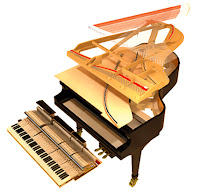 |
| Physical Modeling Virtual Technology |
So when it comes to looking for unfiltered, unadulterated, natural piano sound and expression which is ultimately what everyone wants who is shopping for a good digital piano, at this point in my opinion, Roland's Physical Modeling technology is giving a person the ability to have a natural piano playing experience than ever before. It's still not "perfect" because after-all, a digital piano is obviously not an acoustic piano, but the Roland HP603, HP605, LX7, and LX17 gets you closer to feeling like you're playing an acoustic piano than on previous models. Whether or not YOU can distinguish the difference between a traditional sampled piano sound and the way it behaves when playing a song, and that same song played on a piano with Physical Modelling technology such as what is in these new Roland pianos, that is what really counts. In my opinion many people may have a difficult time in determining (on their own) those differences primarily because most people don't know what a real piano actually sounds like, or if they do, they don't play well enough for those differences to really matter. But at the end of the day, if you want to know that you have that capability in the piano and that it is a close as possible with regard to acoustic properties, then the new Roland's will do a great job when it comes to acoustic piano sound realism in a digital piano furniture cabinet...although as I said, it's certainly not perfect and their are a couple of noticeable sound anomalies (at least they are noticeable to me) which I do not find on real acoustic pianos.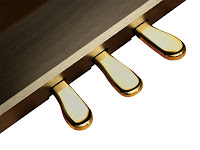
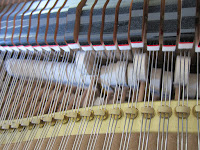 I did want to mention something about pedaling and the fact that without proper pedaling response and reproduction in the sound that occurs from pedaling, especially with the right damper pedal) the playing the piano would not be enjoyable. The right damper pedal is what makes the song sound good and sound correct. It produces the sustain which holds the notes for a duration of times after you play the key(s) while the right pedal is help down. Physically it's a fairly simple process overall pushing down the pedal and playing the notes, but in reality the process is much more complex as far as what you will hear when doing that. In the world of digital pianos one of the most noticeable things that occurs with the right damper/sustain when holding it down while playing notes is the lack of sustain/decay time, especially on the middle octaves up through the last octave. In other words, the decay time of the notes die off pretty quickly when the sustain pedal is held down and so the song is more choppy and the transitions between notes and chords are not nearly as realistic as they should be. In a real acoustic piano when you press the right damper pedal down, you will not only get long sustain time but also the sustained volume will stay louder and stronger as well as the interaction of the sustained strings sound more complex with noticeable overtones, harmonics, and a variety of vibrations all happening in real time. I have never heard the piano tone sound so real when using a damper pedal in a furniture cabinet digital piano in this price range with a digital piano. *However, occasionally when playing certain chords or notes together in various octaves, especially in the middle octaves, I did notice a bit too much mid range sustained tones (especially when I was using the damper pedal) that were unlike a real piano and they stood out to me. This gave me the impression that the sustained piano tone (while using the damper pedal) was somewhat overdone and not natural as they should have been. I tried to compensate for this by editing the sound in different ways with sound editing functions as well as reducing sustain/decay time with less pedaling, and that did help a little, but did not eliminate it altogether and it was still noticeable to me. As with all new technologies, physical modelling is not perfect yet and Roland will no doubt get it to become better over the years to come, but for now it's still very impressive. Roland also uses continuous pedal recognition which follows your incremental pedal movements instead of having just the standard half-pedal recognition found in other brands. Nevertheless, it was very nice for me to experience all these features in these new Roland pianos and until you get to a more advanced piano playing skill level where you can really appreciate these features, it may not matter to you...but I guarantee it does make the music become more alive and sound more authentic. The middle and left pedals do function well and will stand up to more advanced players. But because those pedals are not played near as much as the right pedal, then the right pedal is the one most people will be familiar with and if that's what you want then overall you should be very happy with the pedaling functions and features.
I did want to mention something about pedaling and the fact that without proper pedaling response and reproduction in the sound that occurs from pedaling, especially with the right damper pedal) the playing the piano would not be enjoyable. The right damper pedal is what makes the song sound good and sound correct. It produces the sustain which holds the notes for a duration of times after you play the key(s) while the right pedal is help down. Physically it's a fairly simple process overall pushing down the pedal and playing the notes, but in reality the process is much more complex as far as what you will hear when doing that. In the world of digital pianos one of the most noticeable things that occurs with the right damper/sustain when holding it down while playing notes is the lack of sustain/decay time, especially on the middle octaves up through the last octave. In other words, the decay time of the notes die off pretty quickly when the sustain pedal is held down and so the song is more choppy and the transitions between notes and chords are not nearly as realistic as they should be. In a real acoustic piano when you press the right damper pedal down, you will not only get long sustain time but also the sustained volume will stay louder and stronger as well as the interaction of the sustained strings sound more complex with noticeable overtones, harmonics, and a variety of vibrations all happening in real time. I have never heard the piano tone sound so real when using a damper pedal in a furniture cabinet digital piano in this price range with a digital piano. *However, occasionally when playing certain chords or notes together in various octaves, especially in the middle octaves, I did notice a bit too much mid range sustained tones (especially when I was using the damper pedal) that were unlike a real piano and they stood out to me. This gave me the impression that the sustained piano tone (while using the damper pedal) was somewhat overdone and not natural as they should have been. I tried to compensate for this by editing the sound in different ways with sound editing functions as well as reducing sustain/decay time with less pedaling, and that did help a little, but did not eliminate it altogether and it was still noticeable to me. As with all new technologies, physical modelling is not perfect yet and Roland will no doubt get it to become better over the years to come, but for now it's still very impressive. Roland also uses continuous pedal recognition which follows your incremental pedal movements instead of having just the standard half-pedal recognition found in other brands. Nevertheless, it was very nice for me to experience all these features in these new Roland pianos and until you get to a more advanced piano playing skill level where you can really appreciate these features, it may not matter to you...but I guarantee it does make the music become more alive and sound more authentic. The middle and left pedals do function well and will stand up to more advanced players. But because those pedals are not played near as much as the right pedal, then the right pedal is the one most people will be familiar with and if that's what you want then overall you should be very happy with the pedaling functions and features.th regard to all of the fundamental parts of piano playing which I have just talked about including key action, piano sound, and pedaling. if all there was on these pianos were just these parts of a piano and you just turned on the power and started playing, that may be enough for some people. But for other people who enjoy "tweaking" and customizing the sound, feel, and overall piano playing response, Roland has included a huge amount of editing functions for just that very purpose. In fact many of these functions are quite useful and allow people the opportunity of personalizing the playability and piano sound to their particular tastes and playing experience in a number of ways and these features are fairly easy to use although they may be "over-the-top" for some people. But that's OK because it's better to have them then to not have them in my opinion. In regular acoustic pianos there are ways that a piano technician-tuner can personalize and customize the piano sound and key action but that can be an expensive process. In the Roland digital pianos this process is in the "digital domain" so it's free, right at your fingertips by the press of a couple of buttons and you use your ears, fingers, and foot to determine what you like and don't like. Once you make a change to the overall piano sound you can then save it to a power-up memory. However the piano also has an instant memory feature which saves your changes as you go
without needing to do anything extra...a very cool feature that I have not seen before in pianos like these. If you don't want those saved changes anymore you can then just reset the piano easily to the factory default settings. Some of the sound editing changes that you can do include Grand Piano Lid height position, Key Off
Noise, Hammer Noise, Duplex Scale adjustment, Full Scale String Resonance, Damper Resonance, Key Off Resonance, Cabinet Resonance, Soundboard Type, Damper Noise, Single Note Tuning, Single Note Volume, Single Note Character, 100 levels of key touch velocity (the way the keys respond to your touch) along with multiple levels of Ambience/Reverb and Brilliance customization. All of the functions and buttons are accessed along the top the keys on the control panel. In my opinion this is the most intuitive and usable placement of controls, display screen, and button placement on a digital piano and Roland is the only brand which offers this kind of setup. Kawai & Yamaha place their controls and display screen to the left of the keyboard which in my opinion and playing experience is much less intuitive and awkward to use and is not in the line of sight. Also, you cannot cover the control buttons or display screen on any of the other major brands and models of digital pianos (except for the Kawai CS10) like you can with the Roland key cover position adjustment (more about that below). So when it comes to just playing the piano, you can do it the old traditional way and simply power up the Roland piano and play, or you can edit and personalize it in just about any way you want to and see it in the nice LCD display screen in the center of the piano above the keyboard...where it should be located.
Ok...so now it's on to some of the useful digital features and non-piano sounds and functions these new pianos have. The new Roland pianos have 4 Physical Modeled Steinway grand piano sounds including Concert, Ballad, Mellow, and Bright with the ability to edit them in 100's of ways as I mentioned earlier. It is not the
quantity of individual piano sounds that count but it is the quality. Beyond those physical modeled sounds are the addition of 8 more piano types including upright, ragtime, and Forte pianos. There are a total of 307 instrument sounds on the new Roland pianos including some outstanding symphony string orchestras, vintage
harpsichords, vintage electric pianos, pipe and pop organs, church and pop choirs, concert harp, classical guitar, oboe, concert flute, jazz saxophone, bluegrass banjo, synthesizer, movie sound effects, and just about anything else you can think of. However, the new Roland pianos have an annoying issue with regard to uchanging instrument sounds when you are playing (including the piano sounds) that they did not have on previous models, and this is called "all notes off" functioning. This means when you change from one sound to the next such as piano to harpsichord, concert piano to mellow piano, electric piano to strings, guitar to flute, etc, if you are holding down one of more keys (and/or holding down your sustain pedal) to continue to hear the current sound and then changing sounds in the control panel to go to the next one you want, the current sound immediately cuts off and stops playing until you re-key and start playing again. This is especially annoying when playing in a live setting, event, etc, and wanting to change sounds in the middle of a song. The sound to sound transition is not smooth, but instead it's choppy and just irritating. It's interesting to note that on previous Roland LX and HP models for many years they did not have this problem and changing sounds was smooth, flowing, and worked fine. However perhaps this issue is due to the new Physical Modeling technology and Roland has not figured out a way to overcome this noticeable anomaly? I personally play in a lot of "live situations" and count on being able to change sounds quickly and smoothly during a performance with any "hiccups." But on the new Roland pianos this is not possible unless Roland can come up with an update to solve this problem. With regard to all of these "extra instrument sounds,"a lot of people say to me "I don't want or need a lot of extra instrument sounds, so if the piano just has some great piano tones, key action, and pedaling, then that's my main focus." As a piano teacher and pro musician I totally understand and agree with that to a point, but there are some good reasons to have all of those extra instrument sounds on the piano such as being able to make a multitrack, multi-instrument recording or using what is called "General MIDI" song playback. Copyright 2016 AZPianoNews.com
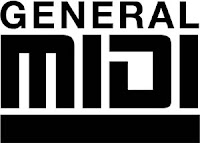

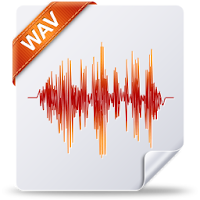
All Roland piano HP/LX models play back General MIDI song files from a USB flashdrive which is a great feature and one I use quite often in my studio. The General MIDI/GS song format allows you to play your piano parts live along "with the band or orchestra" in prerecorded MIDI songs and to interact with multiple instruments (up to 16 tracks) at one time using well known piano lesson books including thousands of popular songs from a variety of music styles and eras such as Jazz, Latin, Country, Rock, Gospel, Christian, movie themes, classical orchestra, pop, and much more which can be found on the Internet. Some of this music is free and some costs money. For more info on the General MIDI format go here: General MIDI and Playing Piano. The MIDI song titles (and page numbers depending on the files) can be accessed and seen from the LCD user display screen on the piano which makes using it much more intuitive as compared to only having LED display screens or none at all. With Yamaha Clavinova CLP digital pianos for example, the only model that has the General MIDI song format is the top of the line CLP585 which is priced at $5000 and up. With Kawai digital pianos the only cabinet model with General MIDI playback format is priced at about $2500US which is good but unfortunately none of the non-ensemble models above that one has the General MIDI song playback format. However, all of these new Roland pianos have this helpful and entertaining songplay and lesson learning format starting at under $3000US, so their models cover all the price ranges and cabinet styles. Roland has a number of other ways its pianos can record music and play back songs for music education & learning that are quite useful and can be important when trying to learn music whether you are a beginner or professional. The recording and play back can be done as a 1-track audio WAV file which allows you to have an actual CD quality song that can be played on other devices such as your computer or converted to a MP3 audio file to play on an iPad, iPod, or iPhone. The pianos can also record 3-track MIDI so you can have separate right-hand, left-hand, and accompaniment tracks recorded individually and then played back as one song...it's simple and fun to do. Typically most people only need or use 3 tracks of recording because you may want to hear your left hand piano part, your right hand piano part, and an orchestral accompaniment part. Some digital piano brands (like Yamaha) offer more than 3 tracks of recording in their models and up to 16-tracks of non General MIDI recording....which is nice to have but I find the extra recording tracks are seldom used by most people. The General MIDI 16-track playback format is much more important for music enjoyment and learning in my opinion because most MIDI music on the internet has been recorded using this format. Roland has been building professional recording & music learning devices for musicians, teachers, and students for years who use them in their home or studio (as I do) for more effective practice sessions. If you want to know more about this you are welcome to contact me.
All of the new Roland pianos offer the standard functions of layering two sounds together, splitting two sounds with one on the right hand and the other sound on the left hand, being able to play in a duet "twin piano" mode where two people can play at the same time by having 44-notes each playing the same octaves, and being able to transpose your live and/or recorded music to any key with a dedicated transpose button. The duet mode is good for teacher-student practice or for two family members practicing the same song at the same time...and you can do this all in privacy using headphones. One of the brand new features on the Roland pianos that Roland has never had on previous models is called registration memories and there is a control panel direct access button to access this function. In the past if you made some editing changes on the piano or set up some layers and split sounds, or wanted to change sounds within a song as you play it, you could not save them in memory for later recall. Saving them in "digital memory" would be especially useful for people who play in real time for events, for church, etc where you would likely be playing a variety of song sand want to set up each song a bit differently for sounds and features. rather than having to do these different setups "live" each time you played that song. The new registration memories allow you to pre-set these "registrations" or memories with the exact instrument sounds and functions you want to have and save them for later instant recall. This is a very useful feature and I certainly would be using it because I like to make changes to the sounds and functions (such as reverb amount, key touch, or instrument sounds) when I play different songs or even within the same song. With the new registration memories, of which there are 25 of them, this is now possible and I am very happy to see this new feature. You can even offload thosesetups to a USB flashdrive and store them in the flashdrive or on your computer if you feel these setups are important so they don't get lost. This process would also allow to save more than 25 setup memories because you can offload as many as you want to. It is important to note that the registration memories do not save all features and functions on the piano, but they do save the primary features that most people would care about.
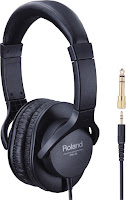 A lot of people use headphones when they are playing a digital piano for private practice so that other people in the room/house are not disturbed. This is obviously something you cannot do with a standard acoustic piano and therefore is a very big reason why people buy digital pianos...to play in privacy. Let's face it, when someone in the house wants to practice their lesson or just wants to play for pleasure and there are other people in the home who are talking or watching TV, etc, it can cause a conflict. So using headphones for piano playing allows for more time playing the piano and if that can happen then I am all for it! On the new Roland pianos there is a special "3D effect" built into the piano headphone circuitry that will go through stereo headphones which can make using headphones even more enjoyable. The 3D effect is supposed to give you the feeling the piano sound is all around you coming from different directions. Roland calls it "an immersive sound experience" which makes it seem like
A lot of people use headphones when they are playing a digital piano for private practice so that other people in the room/house are not disturbed. This is obviously something you cannot do with a standard acoustic piano and therefore is a very big reason why people buy digital pianos...to play in privacy. Let's face it, when someone in the house wants to practice their lesson or just wants to play for pleasure and there are other people in the home who are talking or watching TV, etc, it can cause a conflict. So using headphones for piano playing allows for more time playing the piano and if that can happen then I am all for it! On the new Roland pianos there is a special "3D effect" built into the piano headphone circuitry that will go through stereo headphones which can make using headphones even more enjoyable. The 3D effect is supposed to give you the feeling the piano sound is all around you coming from different directions. Roland calls it "an immersive sound experience" which makes it seem like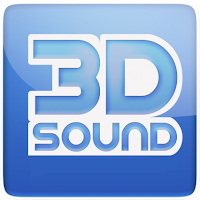 you're not actually wearing headphones at all...and that's really the point of this feature. I tried it out and found that overall, it had a natural effect and I believe most people will enjoy it. It actually did sound like I wasn't wearing headphones...although I was:). This is fairly new technology in digital pianos and it's a nice feature to have especially if you'll be using headphones often. The 3D headphone sound effect only works when the ambiance button on the piano control panel is selected and it can be turned on or off or controlled in incremental levels. Also, it's important to have/own good sounding stereo headphones for private playing because you want to capture all the nuances of the new enhanced Roland piano sound dynamics and tonal qualities and many low priced headphones don't do that. You don't need specific headphones to have that 3D effect but I can give you some good recommendations for quality stereo headphones if you don't already have some.
you're not actually wearing headphones at all...and that's really the point of this feature. I tried it out and found that overall, it had a natural effect and I believe most people will enjoy it. It actually did sound like I wasn't wearing headphones...although I was:). This is fairly new technology in digital pianos and it's a nice feature to have especially if you'll be using headphones often. The 3D headphone sound effect only works when the ambiance button on the piano control panel is selected and it can be turned on or off or controlled in incremental levels. Also, it's important to have/own good sounding stereo headphones for private playing because you want to capture all the nuances of the new enhanced Roland piano sound dynamics and tonal qualities and many low priced headphones don't do that. You don't need specific headphones to have that 3D effect but I can give you some good recommendations for quality stereo headphones if you don't already have some. 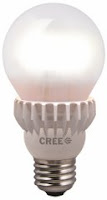 The speaker/audio system in each model is very impressive because Roland is using new audio technology not previously available on their pianos before. The best way for me to explain this is by referring to light bulbs. Most people know that saving electric energy and consuming less is the best way to go. The recent changes to light bulb technology now allows for a powerful bright light bulb which uses far less energy because of the new LED technology. So basically this means that instead of using 60 watts of power (per hour) to get 60 watts of light bulb brightness, the new LED bulbs use approx 14 watts of power to get 60 watts of brightness...and those new light bulbs last much longer because they are not using as much power as before. So when it comes to sound technology, it's mostly all about wattageefficiency while offering good powerful volume (aka:decibel level) going through quality speakers and amplifiers that disperse the piano sound correctly and in a way that is most natural. Although having a lot of wattage power is not a bad thing in terms of achieving volume and sound fullness, that type of power method is using "old school" components at this point which are typically inefficient, more costly, and not as effective overall in many cases. It seems like many people want to go "green" these days so using less power and not having to replace components as often is a very good thing.
The speaker/audio system in each model is very impressive because Roland is using new audio technology not previously available on their pianos before. The best way for me to explain this is by referring to light bulbs. Most people know that saving electric energy and consuming less is the best way to go. The recent changes to light bulb technology now allows for a powerful bright light bulb which uses far less energy because of the new LED technology. So basically this means that instead of using 60 watts of power (per hour) to get 60 watts of light bulb brightness, the new LED bulbs use approx 14 watts of power to get 60 watts of brightness...and those new light bulbs last much longer because they are not using as much power as before. So when it comes to sound technology, it's mostly all about wattageefficiency while offering good powerful volume (aka:decibel level) going through quality speakers and amplifiers that disperse the piano sound correctly and in a way that is most natural. Although having a lot of wattage power is not a bad thing in terms of achieving volume and sound fullness, that type of power method is using "old school" components at this point which are typically inefficient, more costly, and not as effective overall in many cases. It seems like many people want to go "green" these days so using less power and not having to replace components as often is a very good thing.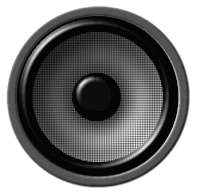

With this in mind, Roland calls their new sound technology "Acoustic Projection" starting with the newHP603 which has 60 watts of total audio power going into 2 amplifiers and 2 speakers while consuming only 9 watts of power (similar to my light-bulb analogy) and pushing out a maximum of 106dB of sound pressure (decibel audio volume). The HP605 has 74 watts of total audio power going into 4 amplifiers and 6 speakers but consuming only 11 watts of power energy and pushing out a maximum of 109dB of sound pressure volume. The new LX7 also has 74 watts of power going through 4 amplifiers and 6 speakers but four of those speakers (2 pair/one large pair, 1 smaller pair) are housed in their own internal cabinets for each pair (aka: speaker box) within the piano and generate a bigger sound with two near the top, two near the keyboard, and two below pointing forward (instead of pointing down in the lower models). The LX7 consumes only 11 watts of powerpushing out a maximum of 112dB of sound pressure power. I will say however that I was a bit disappointed in the LX7 bass frequency response because it could have been much better, deeper, and fuller and the previous model Roland HP508 was more to my liking in that way. The LX7 has plenty of volume, just not near as full sounding as a real upright or grand piano. The top of the line LX17 also has 74 watts of total power but that power is going through 6 amplifiers and 8 speakers with 2 of those speakers being large 10" bass reflex speakerswith dedicated amplifier power which makes that piano sound like a huge acoustic grand. The power consumption on theLX17 is only 13 watts pushing out a maximum of 112dBsound pressure volume, which is very loud if you really want it to be that way. Just to give you a sense of what dB's translate to, a powersaw at 3' away is approx 110dB's of sound pressure volume and a loud rock concert is approx 115dB's of volume! So when we're talking 106dB to 113db in volume on Roland pianos, we're talking about a lot of sound/volume power. These new internal audio systems give a more balanced approach to recreating the acoustic piano playing experience in my opinion and it really makes these new pianos sound much more like they are natural acoustic pianos without speakers. When you look at previous model Roland pianos along with other popular brands, most people have been concerned almost exclusively with "audio power output" such as 40 watts, 60 watts, 100 watts, 150 watts, 200 watts, etc. But that is not necessarily a good reflection of actual maximum volume or quality of sound anymore. Think of that new LED light bulb along with new electronic products, new appliances, new cars, and other new consumer products that use energy. They are all moving towards efficiency in energy consumption while putting out more quality sound, more power with less consumption, better construction, more usable functions, and a variety of advanced features they never have had in the past. Roland has been in the professional pro audio business for many years (I have owned and used some of their pro audio speakers) so they do have experience in this area and it definitely shows in these new digital pianos. I will say that I noticed the HP603, even with its good dB level and 60 watts of rated power, to still sound a bit weak when I played it near full volume. I expected a bigger, fuller sound on the HP603 and for some reason I did not get that and it even sounded a bit over-driven to me. Perhaps it had to do with only having 2 smaller speakers or the way the cabinet was designed, I really don't know. I did not think the volume and fullness of sound was better to the lower priced HP504 model at only 24 watts rated power. However the HP504 still has the 106 dB level of the HP603, so maybe that's where the issue lies? In any case, for the price, I expected more out of the Roland HP603 when it comes to output volume and fullness/bassiness of the piano sound through its internal speaker system as compared to other digital pianos I have played.
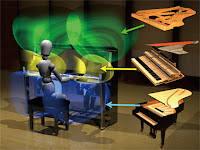
When it comes to sound, it's all about what you hear because that counts in the end. So don't let something like the new $7000 LX17 at 74 watts power output make it seem like it must not sound good or be as loud as a 180 watt output system that uses more energy. A good example of this would be the new Yamaha CLP585 top of the line model vs the Roland LX17 top of the line model. The Yamaha puts out 180 watts of total power going through 6 speakers and consumes 60 watts of power for that effort. The power output of the Yamaha digital piano is almost 2.5 times as much as the Roland, but it uses over 4.5 times as much energy to do so. However, the LX17 has 8 speakers as opposed to 6 speakers in the Yamaha and largest Yamaha speaker in that model is a little over 6.25" vs the largest Roland speakers in the LX17 at 10" each. The huge bass response in the Roland along with 2 additional speakers with all speakers laid out in the cabinet in a unique way actually gives the Roland sound system a big advantage in volume and sound quality in my opinion while using a lot less energy doing so. When I played the LX17, the internal sound system was a pretty incredible listening experience (like a big grand piano) and not one I have had on any other new vertical digital piano before even at 3 times the wattage power output. My best guess is that the other brands will need to play "catch up" with this new Roland sound technology but I am assuming that one day they will. But for now...it's clearly Roland who is at the top when it comes to these internal speaker systems.

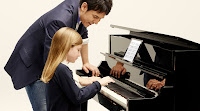 Another new technology now being put into these new Roland pianos is Bluetooth device connectivity. Bluetooth in digital pianos is relatively new and encompasses a number of separate features. So when you hear the word "Bluetooth" in digital pianos, it doesn't mean they all do the same thing or can do everything associated with the Bluetooth technology. With the exception of the HP603 (no BT audio), the Roland Bluetooth functions offer a three different uses including BT audio streaming so that you can hear the sound from your Bluetooth capable external device (tablet, cell phone, computer, etc) come through the piano speaker system. Another Bluetooth feature is MIDI streaming connectivity so that you can interact with Bluetooth capable apps or programs such as Garage Band for iPad which is a great MIDI music and recording app. It is very popular for music education and lots of fun to use. So not only will the app respond to your Bluetooth input from the piano as you play the keys, but you can also hear the music audio coming from that app through the piano speakers. A third Bluetooth function is "pedal Air page tuning. This BT feature allows you to open up sheet music on your tablet with apps that have this "Air Page Turn feature so that you can download and read sheet music from your tablet and instantly turn the virtual pages by pressing a foot pedal on your piano exactly when you need to. One of those sheet music/page turning apps is called piaScore. With piaScore you can play thousands of songs from a free sheet music library through your tablet and turn the pages with Bluetooth page turner, and I previously mentioned. You can also import your own sheet music into the piaScore app so that you can have a custom library of songs that you can read directly from the app on your tablet device and be able to turn the sheet music pages with your Roland foot pedal page turner. So when it comes to Bluetooth and using that technology, there are still many apps that have not set up Bluetooth MIDI and/or Bluetooth audio or page turning yet. But as time moves along more and more of these app developers will do that to their music apps. In the meantime if you find some good iPad/Android music apps in the app store that respond to MIDI and audio but don't have Bluetooth implementation yet, you can still connect the Roland piano to your tablet with the use of a USB connecting cable along with an audio cable which will do the same thing as Bluetooth audio and MIDI with the exception that it will not be wireless. But for many people that is just fine and the fact is you'll still be properly connected with your Roland piano.
Another new technology now being put into these new Roland pianos is Bluetooth device connectivity. Bluetooth in digital pianos is relatively new and encompasses a number of separate features. So when you hear the word "Bluetooth" in digital pianos, it doesn't mean they all do the same thing or can do everything associated with the Bluetooth technology. With the exception of the HP603 (no BT audio), the Roland Bluetooth functions offer a three different uses including BT audio streaming so that you can hear the sound from your Bluetooth capable external device (tablet, cell phone, computer, etc) come through the piano speaker system. Another Bluetooth feature is MIDI streaming connectivity so that you can interact with Bluetooth capable apps or programs such as Garage Band for iPad which is a great MIDI music and recording app. It is very popular for music education and lots of fun to use. So not only will the app respond to your Bluetooth input from the piano as you play the keys, but you can also hear the music audio coming from that app through the piano speakers. A third Bluetooth function is "pedal Air page tuning. This BT feature allows you to open up sheet music on your tablet with apps that have this "Air Page Turn feature so that you can download and read sheet music from your tablet and instantly turn the virtual pages by pressing a foot pedal on your piano exactly when you need to. One of those sheet music/page turning apps is called piaScore. With piaScore you can play thousands of songs from a free sheet music library through your tablet and turn the pages with Bluetooth page turner, and I previously mentioned. You can also import your own sheet music into the piaScore app so that you can have a custom library of songs that you can read directly from the app on your tablet device and be able to turn the sheet music pages with your Roland foot pedal page turner. So when it comes to Bluetooth and using that technology, there are still many apps that have not set up Bluetooth MIDI and/or Bluetooth audio or page turning yet. But as time moves along more and more of these app developers will do that to their music apps. In the meantime if you find some good iPad/Android music apps in the app store that respond to MIDI and audio but don't have Bluetooth implementation yet, you can still connect the Roland piano to your tablet with the use of a USB connecting cable along with an audio cable which will do the same thing as Bluetooth audio and MIDI with the exception that it will not be wireless. But for many people that is just fine and the fact is you'll still be properly connected with your Roland piano. 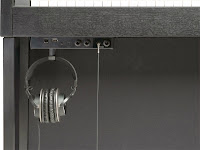 Speaking of connectivity, all of the new Roland models have good connectivity to external devices with outputs and inputs including dual headphone jacks, stereo mini input audio jack to connect tablets, computers, iPod, etc to hear audio through the piano, two 1/4" audio output jacks for stereo connectivity with external sound systems, USB flashdrive input, and USB output to device. This kind of connectivity is generally sufficient to meet most needs although all the jacks themselves are located under the left front of the pianos. This is fine for some connections but I would have much preferred to see the audio input and output jacks along with the USB output located on the back of the piano like most of the other brands do. It would be the more practical position for those connector jacks, but perhaps Roland had a reason for locating all of them up front underneath the piano...maybe it was less money for them to do it that way...but I don't like it. If you want to run an external device such as an iPad or computer to your piano then the audio cable needs to be routed to the front of the piano and same is true of a USB connected. Cables and connectors, especially audio output cables, should not be seen or get in the way of the player, but they do on the new Roland pianos and that would have been easy to do differently such as on past Roland models. It's definitely not a "deal breaker" for me but it is an annoyance.
Speaking of connectivity, all of the new Roland models have good connectivity to external devices with outputs and inputs including dual headphone jacks, stereo mini input audio jack to connect tablets, computers, iPod, etc to hear audio through the piano, two 1/4" audio output jacks for stereo connectivity with external sound systems, USB flashdrive input, and USB output to device. This kind of connectivity is generally sufficient to meet most needs although all the jacks themselves are located under the left front of the pianos. This is fine for some connections but I would have much preferred to see the audio input and output jacks along with the USB output located on the back of the piano like most of the other brands do. It would be the more practical position for those connector jacks, but perhaps Roland had a reason for locating all of them up front underneath the piano...maybe it was less money for them to do it that way...but I don't like it. If you want to run an external device such as an iPad or computer to your piano then the audio cable needs to be routed to the front of the piano and same is true of a USB connected. Cables and connectors, especially audio output cables, should not be seen or get in the way of the player, but they do on the new Roland pianos and that would have been easy to do differently such as on past Roland models. It's definitely not a "deal breaker" for me but it is an annoyance.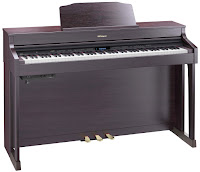
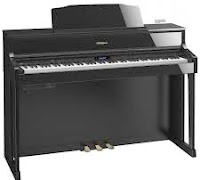 When it comes to the cabinet design of these digital pianos and digital pianos in general, the more they appear to look like pianos the better people seem to like it, and I would agree with that. So with regard to the appearance and size of these new models, I think Roland made them look better than ever and I like the way their new design as well as cabinet color choices, which I mentioned at the beginning of this review. The HP603 weighs in at 110 lbsmeasuring approx 55" wide, 17" deep, and 42" tall with the music rack up. The HP605 weighs in at 120 lbs measuring approx 55" wide, 17" deep, and approx 44" tall with the music rack up. The LX7 has a very unique cabinet design like no other digital piano cabinet I have seen before and this is a brand new look for a Roland piano. The LX7 has the most traditional piano cabinet of all in my opinion, but still looks contemporary and classy and I think a lot of people will like this one. It also is available in a color finish which no other brand in this price range offers and Roland has never offered in the past. That finish is called contemporary satin walnut and it is very attractive in my opinion and the wood grain in the LX7 cabinet has an elegant appearance with unusual grain direction and design. This is also true of the satin black finish as well. The LX7 weighs in at 170 lbs measuring approx 55" wide, 18" deep, and 41" tall. The music rack has two positions and can be adjusted slightly out from cabinet which is another unique feature. The top of the line LX17 has the tallest cabinet of any top of the line major brand digital piano that I know of. The LX17 weighs in at 193 lbs measuring 56" wide, 19" deep, and 45" tallwith the lid propped up (approx 42" tall with the lid down). One of the unique features of the LX17cabinet is that the top opens/props up at an angle and will stay up to allow piano sound to come up and out of the top of the piano like it would on a grand piano with the lid up. So not only does theLX17 have a beautiful cabinet design and finish, but this extra lid opening features also enhances the sound that you hear to make it more life-like. Neither Yamaha or Kawai has this cabinet feature on their digital pianos and it does make a distinct difference...it's not just for looks.
When it comes to the cabinet design of these digital pianos and digital pianos in general, the more they appear to look like pianos the better people seem to like it, and I would agree with that. So with regard to the appearance and size of these new models, I think Roland made them look better than ever and I like the way their new design as well as cabinet color choices, which I mentioned at the beginning of this review. The HP603 weighs in at 110 lbsmeasuring approx 55" wide, 17" deep, and 42" tall with the music rack up. The HP605 weighs in at 120 lbs measuring approx 55" wide, 17" deep, and approx 44" tall with the music rack up. The LX7 has a very unique cabinet design like no other digital piano cabinet I have seen before and this is a brand new look for a Roland piano. The LX7 has the most traditional piano cabinet of all in my opinion, but still looks contemporary and classy and I think a lot of people will like this one. It also is available in a color finish which no other brand in this price range offers and Roland has never offered in the past. That finish is called contemporary satin walnut and it is very attractive in my opinion and the wood grain in the LX7 cabinet has an elegant appearance with unusual grain direction and design. This is also true of the satin black finish as well. The LX7 weighs in at 170 lbs measuring approx 55" wide, 18" deep, and 41" tall. The music rack has two positions and can be adjusted slightly out from cabinet which is another unique feature. The top of the line LX17 has the tallest cabinet of any top of the line major brand digital piano that I know of. The LX17 weighs in at 193 lbs measuring 56" wide, 19" deep, and 45" tallwith the lid propped up (approx 42" tall with the lid down). One of the unique features of the LX17cabinet is that the top opens/props up at an angle and will stay up to allow piano sound to come up and out of the top of the piano like it would on a grand piano with the lid up. So not only does theLX17 have a beautiful cabinet design and finish, but this extra lid opening features also enhances the sound that you hear to make it more life-like. Neither Yamaha or Kawai has this cabinet feature on their digital pianos and it does make a distinct difference...it's not just for looks. 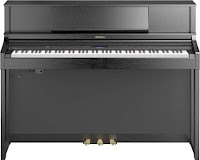
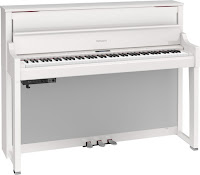 A few more unique features about the new cabinets is the new front lower (privacy) panel design. In past digital piano models the privacy panel was attached to the back of the piano pedalboard so that there was space (about 6") between the back of the pedals themselves and the very back of the piano...which is not how real upright pianos are built. The full size privacy (aka: kick panel) panel on a regular upright piano is flush with the back of the pedals and therefore digital piano cabinets tend to look "fake" in this way as compared with real pianos. So this new "look" makes the all the Roland pianos very realistic in design and they look great (see left pics). Neither Yamaha or Kawai has this acoustic upright cabinet design feature, only Roland. Another new aspect of the Roland cabinet design is something the other major brands do not have. When you close the key cover on all these new Roland models (except for the LX17), there are 2 key cover positions that allow you to close the cover over the control panel buttons without covering the entire keyboard. It gives your piano a minimalistic look while you are playing the piano and yet the control buttons can be exposed to make changes to the functions if you want to do that. When you are through playing the piano then you simply slide the key cover the rest of the way out to cover up the keyboard. The LX17 has a traditional slow-close "fallboard" type key cover that pulls/falls down over the keys like on a grand piano. Although there is not the 2 position slide-out key cover on the LX17, the grand type fallboard key cover is still a very nice upgrade. When you cover the entire keyboard on any of the models the power automatically shuts off without you need to physically push a button or flip a switch. This feature is a definite power saver and is very convenient to have. When you are ready to play the piano then you just open up the key cover and the power automatically comes on without touching any buttons. Speaking of
A few more unique features about the new cabinets is the new front lower (privacy) panel design. In past digital piano models the privacy panel was attached to the back of the piano pedalboard so that there was space (about 6") between the back of the pedals themselves and the very back of the piano...which is not how real upright pianos are built. The full size privacy (aka: kick panel) panel on a regular upright piano is flush with the back of the pedals and therefore digital piano cabinets tend to look "fake" in this way as compared with real pianos. So this new "look" makes the all the Roland pianos very realistic in design and they look great (see left pics). Neither Yamaha or Kawai has this acoustic upright cabinet design feature, only Roland. Another new aspect of the Roland cabinet design is something the other major brands do not have. When you close the key cover on all these new Roland models (except for the LX17), there are 2 key cover positions that allow you to close the cover over the control panel buttons without covering the entire keyboard. It gives your piano a minimalistic look while you are playing the piano and yet the control buttons can be exposed to make changes to the functions if you want to do that. When you are through playing the piano then you simply slide the key cover the rest of the way out to cover up the keyboard. The LX17 has a traditional slow-close "fallboard" type key cover that pulls/falls down over the keys like on a grand piano. Although there is not the 2 position slide-out key cover on the LX17, the grand type fallboard key cover is still a very nice upgrade. When you cover the entire keyboard on any of the models the power automatically shuts off without you need to physically push a button or flip a switch. This feature is a definite power saver and is very convenient to have. When you are ready to play the piano then you just open up the key cover and the power automatically comes on without touching any buttons. Speaking of buttons, the control panel buttons have been redesigned in their height position to offer a better, more tactile feel than on the previous models. This is a relatively small upgrade but a good one and is something I noticed right away when pressing the buttons to control features in the piano. Even the user display screen has been upgraded and slightly enlarged with more info displayed at one time in the HP603 and HP605 as compared with the previous HP504 & HP506, so that the screens are now the same size in all of the new models. It seems that Roland has thought of everything including these small little perks which I found quite fascinating. Little things can mean a lot over a period of time and no other major brand that I know of offers this kind of cabinet key cover autopower feature in their pianos.
buttons, the control panel buttons have been redesigned in their height position to offer a better, more tactile feel than on the previous models. This is a relatively small upgrade but a good one and is something I noticed right away when pressing the buttons to control features in the piano. Even the user display screen has been upgraded and slightly enlarged with more info displayed at one time in the HP603 and HP605 as compared with the previous HP504 & HP506, so that the screens are now the same size in all of the new models. It seems that Roland has thought of everything including these small little perks which I found quite fascinating. Little things can mean a lot over a period of time and no other major brand that I know of offers this kind of cabinet key cover autopower feature in their pianos.
I usually don't talk about piano benches that come with the pianos because they are typically smaller and not out of the ordinary. However, all of the included Roland matching benches are duet size
which can normally seat two people instead of just one and the bench also opens up for music storage inside. I think this is a very good thing and something that many people ask for. Beyond that, the polished ebony, polished white, and satin walnut cabinets come with even larger and longer duet benches as compared to the regular duet benchwith the other cabinet finishes. These upgraded benches include upgraded hardware, materials, construction, and finishes. By themselves those benches would cost in excess of $200US each so they are not just an after-thought but are USA made custom benches. You may notice pictures of the Roland pianos on various web sites (including the Roland website) showing small adjustable benches.
 Finally, last but definitely not least, the Roland company has just introduced a new warranty on all of the new models that no other manufacturer comes close to.Believe it or not, the warranty has gone from 5 year parts/2 years labor with in-home service on previous models, to a gigantic 10-year parts/10 years labor with in-home service on these new models. That's a very big and unexpected increase in warranty time coverage and is now the longest by far in the digital piano industry. I will admit that based on all my experience with Roland digital pianos as well as with later model Yamaha & Kawai digital pianos, I have seen relatively little breakdown or electronic issues with these brands over a 10 year period of ownership given that the owner treated the piano with care. So typically a good digital piano should not need service over a long period of time...but I believe it's certainly a good thing to know, that for no extra charge, the piano will be protected against manufacturer product defects for 10 full years.
Finally, last but definitely not least, the Roland company has just introduced a new warranty on all of the new models that no other manufacturer comes close to.Believe it or not, the warranty has gone from 5 year parts/2 years labor with in-home service on previous models, to a gigantic 10-year parts/10 years labor with in-home service on these new models. That's a very big and unexpected increase in warranty time coverage and is now the longest by far in the digital piano industry. I will admit that based on all my experience with Roland digital pianos as well as with later model Yamaha & Kawai digital pianos, I have seen relatively little breakdown or electronic issues with these brands over a 10 year period of ownership given that the owner treated the piano with care. So typically a good digital piano should not need service over a long period of time...but I believe it's certainly a good thing to know, that for no extra charge, the piano will be protected against manufacturer product defects for 10 full years. | HP603 satin rosewood |
In the final analysis I believe Roland has finally hit the "sweet spot" in its quest for a great line of digital pianos with its new models by producing instruments that focus on recreating a a more authentic piano playing experience first and foremost along with incorporating this new technology in attractive well built cabinets at price points which are affordable, especially compared to some other digital piano brands and regular new acoustic pianos.
Even though the HP603, HP605, LX7, and LX17 have some very nice digital functions and lots of extra instrument sounds (they do sound great) along with some fun and educational features, these new models seem to really focus on that all important piano playing experience...and for me that's what is most important, especially in this higher price range above the less expensive internet pianos that are out there under $2000US. The new Roland's have no drum patterns, no auto-accompaniment interactive chords, no large color touch display screens, and no digital voice commands. They are mainly for people wanting to play piano, and these instruments are only found at local Roland authorized piano stores in Australia
| HP 603 closed key cover |
Since the new models came out, you may still not be able to find some at local Roland dealers. I do know the LX17 has become very popular and the Roland company has been in short supply of them on and off since they came out. It's really a great piano for the price in my opinion and if you have the budget, the LX17 would be my choice over the other Roland models, but it's good to know that you can get the same new key action, piano sound chip, and pedaling onany of the new models. In fact when using a good pair of stereo headphones, all the models sound identical. That means that if you don't need to fill up a large space in a room with big sound through the internal speakers, or you don't need the upgraded cabinets such as the HP605 (left pic with closed key cover), LX7 or LX17, or perhaps you'll be using headphones most of the time, the new HP603 may be sufficient for your piano playing needs without the extra expense of the other models....although the HP605, LX7, and LX17 certainly are nicer in many ways. Do yourself a big favor, before you make a buying decision on a new digital piano between near $3000-$7000US, if you have not considered these new Roland pianos yet, then you should:). I know that people have different musical expectations and tastes when it comes to playing and listening to piano music, and you could likely be happy with a variety of models and brands in this price range. But I can tell you from my personal experience with them that these Roland pianos are very nice instruments and have reached an impressive level of piano playing authenticity in a digital piano in terms of an overall experience, although I also like Kawai & Casio digital pianos very much in similar price ranges.
 IMPORTANT - One more thing about these new Roland pianos and the Physical Modeling Technology: Since the new Roland piano "sound" is not captured with mics and recording equipment anymore, the algorithms and mathematical computations for achieving this new piano sound better be exactly right because if it is not exactly right, then the piano sound will be skewed and imperfect and the outcome will be essentially no different than the limitations of "sampling" in that the final sound would result in being unnatural. So just because Roland is using this newer technology (physical modeling has actually been around for awhile) does not mean that its "new piano sound" is exactly that of a real acoustic piano. Roland has a long way to go before that happens along with developing a better internal speaker system that would take that piano sound into a higher level of authenticity and Roland is definitely not there yet. But as with all technology, it will continue to progress and grow into something that far surpasses what we have right now...so this is just the beginning. Do your homework and research and then get in touch with me if you have questions or want to find out about how to purchase digital pianos for low prices.
IMPORTANT - One more thing about these new Roland pianos and the Physical Modeling Technology: Since the new Roland piano "sound" is not captured with mics and recording equipment anymore, the algorithms and mathematical computations for achieving this new piano sound better be exactly right because if it is not exactly right, then the piano sound will be skewed and imperfect and the outcome will be essentially no different than the limitations of "sampling" in that the final sound would result in being unnatural. So just because Roland is using this newer technology (physical modeling has actually been around for awhile) does not mean that its "new piano sound" is exactly that of a real acoustic piano. Roland has a long way to go before that happens along with developing a better internal speaker system that would take that piano sound into a higher level of authenticity and Roland is definitely not there yet. But as with all technology, it will continue to progress and grow into something that far surpasses what we have right now...so this is just the beginning. Do your homework and research and then get in touch with me if you have questions or want to find out about how to purchase digital pianos for low prices.
should you require any further information, please visit our web site www.pianoworld.com or email info@pianoworld.com.au phone 03-9497 2616 We can ship Australia Wide at very low cost!
